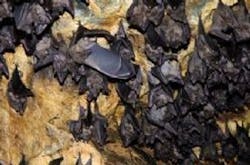Vision system monitors bat behavior in research project
Acomputer vision system developed by the University of Lincoln and the Lincolnshire Bat Group analyzes bat behavior and collects vital data which may enable the researchers to classify species of bat, which may provide information on how to effectively manage and protect buildings the bats inhabit.
Bats frequently roost in buildings such as churches, and corrosive feces left behind by the bats causes damage to the structure and artifacts within a given building, according to theUniversity of Lincoln. As a result, these two groups collaborated on a system which uses a high-speed infrared camera to monitor wing beat frequency and gather data, which may allow the group to classify species of bat. PhD student John Atanbori from the School of Computer Science developed the system along with Dr. Patrick Dickinson.
"Thiscomputer vision technique is able to monitor repeated patterns in wing beat frequency. As specie type can be determined from the way a bat moves its wings this provides vital information not only for conservationists studying the animals, but also building managers and professional ecologists," he said in the press release.
Wing beat frequency is one of the features that can be monitored in order to determine species, but the goal of the project is to eventually be able to identify additional features, such as shape and weight, to provide a more detailed classification, Atanbori added.
All of the data gathered by thevision system is collected by the Lincolnshire Bat Group. Dr. Peter Cowling from the group says that a number of things need to be done in order to conserve bats, including the establishment of the size of current bat populations, identifying which bats are where and how they are responding to threats and pressures.
"By monitoring bats we can discover the factors that are important for their survival. We can identify which species need action now, what areas are important for bats and what threats bats face."
View thepress release.
Also check out:
3D imaging shows that bats take flight using recycled energy
Thermal imaging system protects whales from underwater noise pollution
Vision-enabled robot tracks Great Whites for Shark Week special
Share your vision-related news by contactingJames Carroll, Senior Web Editor, Vision Systems Design
To receive news like this in your inbox,click here.
Join ourLinkedIn group | Like us on Facebook | Follow us on Twitter| Check us out on Google +
About the Author

James Carroll
Former VSD Editor James Carroll joined the team 2013. Carroll covered machine vision and imaging from numerous angles, including application stories, industry news, market updates, and new products. In addition to writing and editing articles, Carroll managed the Innovators Awards program and webcasts.
